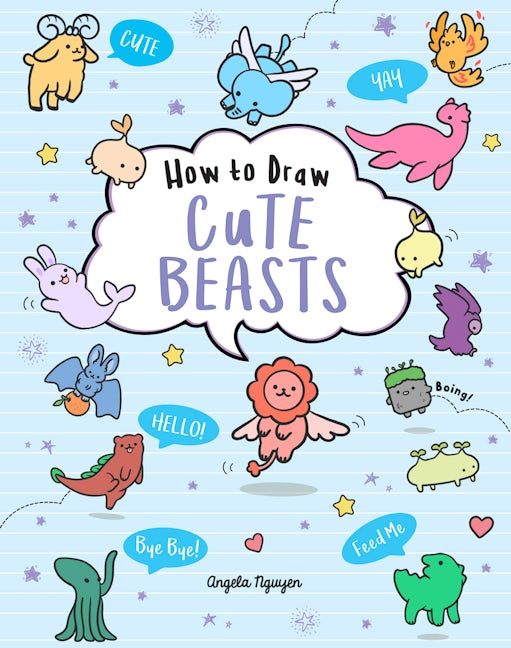How To Draw Cute Beasts by Angela Nguyen. Published by Union Square Kids, 2020.

- Summary-This recent and simply adorable how-to-draw entry from Angela Nguyen presents a cavalcade of fantasy creatures – some classic, some original inventions of the author-illustrator herself! From the “Flyion” (that’s a flying lion) to “Shibarus” ( a 3-headed Shiba Inu), step-by-step guides give readers a clear path to follow along as they draw their own fantastic beasts.
- Target Audience – The target audience range for this book is ages 7-12. In terms of content, the instructions are clear but minimal, using basic shapes and with no more than 3 steps to each drawing. Lines are added gradually in a lighter tone to illustrate their relative placement. While this is obviously beneficial to younger readers and beginner artists (no matter what their age), the simplified style is also, as the title claims very cute and clean-looking without extraneous or uncanny details. Bright pops of color flats are applied to finished drawings to attract readers’ attention, and the visual contrast is striking!
- Strengths and Weaknesses– One strength is the book’s organization: there is an introduction, table of contents, and materials list before readers even get into drawing. The beasts are also categorized by their habitat: water, air, or land. That said, one weakness is the style of the typography in its graphics. Some of the text is free floating and has to fit between or curve around some of the art. These non-standard aspects in the how-to segments could be harder to follow for younger readers, those with dyslexia, or those need of large print.
- Creative uses– There is a small section at the back of the book entitled “Chapter Five: Now Draw Your Own”, which encourages readers to use their imagination and the skills demonstrated by the book thus far and come up with their own cute beast. Ideas include combining animals (bunny + snake might equal an elongated yet fluffy tailed creature or a scaly bunny with fangs) , playing with elemental powers (fire cats and electric puppies), or simply adding parts to existing animals ( a llama with a horn = a llamacorn). Please consider leading a group in creating their own mashup creatures, either by giving them total creative reign over their drawings or by letting them choose creature types and add-ons randomly (either out of a hat or from a mix-and-match list). This would also be a good opportunity to couple information about different real world animals and their special features (horns, claws, wings, etc.), or storytelling centered around monsters, global mythologies, or cryptozoology.
Read-Alikes
- How to Draw Magical Creatures and Mythical Beasts by Mark Bergin– The title more or less says it all: How to Draw Magical Creatures and Mythical Beasts details just that with its line drawings and shading tutorials. This how-to-draw book boasts more complex steps than How To Draw Cute Beasts, and would do well to act as the next step up for readers/artists looking for a different, more detailed line-art style to learn from than the one showcased in Nguyen’s book. While the subject material consists of similar beastly content, one distinction is that these these fantastic beasts are all based in pre-established myth.
- Let’s Draw Storybook Characters by Kasia Dudziuk- This how-to-draw book focuses on more humanoid magical or mysterious characters, utilizing thick and simple linework and soft colors. It bridges outside of fantasy into the niche of mostly fairy tale characters (like dragons and wizards) , although there are still some sci-fi and mythic characters in there as well, like aliens and Santa Claus. It shares its easy to follow shape-based art style with Nguyen and provides even more basic instructions that would be best suited to the younger spectrum of Nguyen’s audience.
- The Book of Mythical Beasts & Magical Creatures by Stephen Krensky and illustrated by Pham Quang Phuc- While not explicitly a how-to-draw book, this bestiary of mythical creatures rooted in traditions from all over the world is sure to delight and inspire both cryptid lovers and artists alike with its gorgeous (and traceable!) full color illustrations, as well as the handy index with page links from one related entry to another. It stands to reason that once readers finish Nguyen’s work, they may be interested to know about more mythical creatures, whether simply to explore or to garner more drawing material. This encyclopedia gives fuller entries and descriptions of each creature, so those who liked that personifying element from the short creature descriptions in Nguyen’s book will appreciate this book even more.